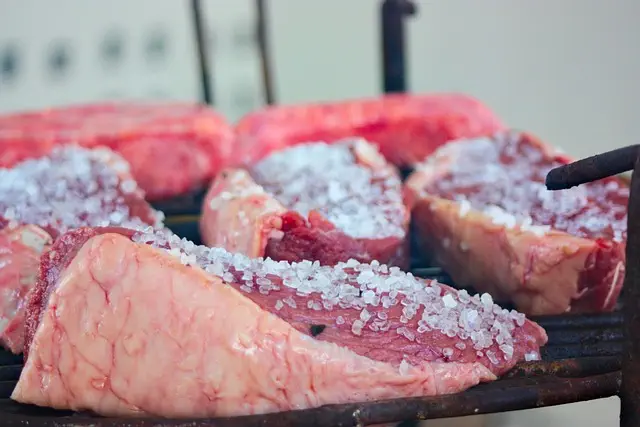Green Maeng Da and Red Bali kratom strains offer distinct anti-inflammatory properties. Green Maeng Da stands out for its high 7-hydroxymitragynine (7-HMG) content, providing potent inflammation reduction and pain relief by inhibiting pro-inflammatory enzymes. Red Bali, with higher mitragynine levels, offers moderate anti-inflammatory effects and is known for its relaxing and alertness-promoting qualities, making it ideal for pain management without drowsiness. The choice between them depends on individual needs, favoring Green Maeng Da for direct inflammation reduction.
Discover the power of kratom in reducing inflammation. This natural herb has gained attention for its potential benefits, with Green Maeng Da and Red Bali emerging as popular strains. Our article compares these two varieties, exploring scientific insights on their anti-inflammatory properties. Learn how these compounds interact with your body’s response to inflammation, offering a new perspective on kratom’s therapeutic uses.
- Green Maeng Da vs Red Bali: Unveiling Their Inflammation-Fighting Properties
- – A comparative analysis of two popular kratom strains and their effects on inflammation.
- Understanding Kratom and Its Anti-Inflammatory Benefits
Green Maeng Da vs Red Bali: Unveiling Their Inflammation-Fighting Properties
When comparing Green Maeng Da and Red Bali kratom strains for inflammation reduction, several key differences emerge. Green Maeng Da is renowned for its potent pain-relieving properties due to high levels of mitragynine, one of the primary alkaloids known for its anti-inflammatory effects. This strain’s ability to interact with opioid receptors in the body makes it a popular choice for natural pain management.
In contrast, Red Bali kratom is known for its relaxing and calming effects, primarily attributed to higher levels of 7-hydroxymitragynine (7-HMG), another potent alkaloid. While still effective against inflammation, studies suggest that Red Bali’s anti-inflammatory action is more subtle compared to Green Maeng Da. Its gentle nature makes it appealing for those seeking a more relaxed and soothing experience rather than intense pain relief. Thus, the choice between these two strains depends on individual needs, with Green Maeng Da being the preferred option for direct inflammation reduction.
– A comparative analysis of two popular kratom strains and their effects on inflammation.
When comparing two popular kratom strains, Green Maeng Da and Red Bali, their effects on inflammation offer distinct profiles. Green Maeng Da, known for its potent pain-relieving properties, has been shown to effectively reduce chronic inflammation thanks to its high levels of 7-hydroxymitragynine (7-HM), a mitragynine derivative linked to anti-inflammatory effects. This strain’s ability to inhibit pro-inflammatory enzymes like COX and LOX makes it a popular choice among those seeking relief from persistent inflammation.
On the other hand, Red Bali is renowned for its relaxing and calming effects, partly due to its higher content of mitragynine itself. While not as potent an anti-inflammatory agent as Green Maeng Da, Red Bali’s ability to modulate inflammatory responses is still significant. Studies suggest it can help manage pain associated with inflammation without causing excessive drowsiness, making it a preferred option for individuals looking for both pain relief and alertness.
Understanding Kratom and Its Anti-Inflammatory Benefits
Kratom, a natural herb derived from the plant Mitragyna speciosa, has gained significant attention for its potential anti-inflammatory properties. Among the various strains, green maeng da and red bali stand out due to their distinct chemical compositions and effects on the body. Green maeng da is renowned for its high levels of 7-hydroxymitragynine (7-HMG), a potent compound with strong anti-inflammatory and analgesic (pain-relieving) properties. On the other hand, red bali is known for its higher levels of mitragynine, another bioactive alkaloid that contributes to its sedative and anti-inflammatory effects.
The anti-inflammatory benefits of kratom are attributed to these alkaloids’ ability to interact with various cellular and molecular pathways involved in inflammation. By inhibiting the production of pro-inflammatory cytokines (signaling molecules) and modulating immune responses, kratom can help reduce inflammation in conditions such as arthritis, chronic pain, and even skin irritations. This natural approach to inflammation reduction offers a promising alternative or complement to conventional anti-inflammatory medications, with potential advantages including fewer side effects and a holistic impact on overall well-being.
Both green Maeng Da and red Bali kratom strains offer unique inflammation-fighting properties. Green Maeng Da’s potent analgesic effects and anti-inflammatory compounds make it a popular choice for pain management. Red Bali, on the other hand, is known for its calming and relaxing properties, which can help reduce chronic inflammation. Understanding the differences between these two strains can help individuals make informed decisions to support their overall health and well-being.






